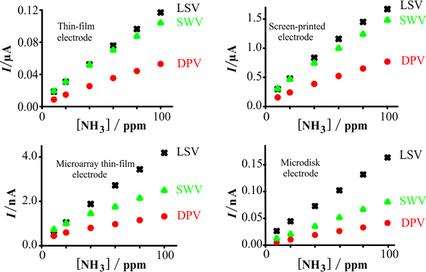当前位置:
X-MOL 学术
›
Electroanalysis
›
论文详情
Our official English website, www.x-mol.net, welcomes your
feedback! (Note: you will need to create a separate account there.)
Comparison of Voltammetric Techniques for Ammonia Sensing in Ionic Liquids
Electroanalysis ( IF 2.7 ) Pub Date : 2017-11-07 , DOI: 10.1002/elan.201700555 Ghulam Hussain 1 , Debbie S. Silvester 1
Electroanalysis ( IF 2.7 ) Pub Date : 2017-11-07 , DOI: 10.1002/elan.201700555 Ghulam Hussain 1 , Debbie S. Silvester 1
Affiliation

|
In electroanalytical chemistry, it is often observed that square wave voltammetry (SWV) and differential pulse voltammetry (DPV) are more sensitive techniques compared to linear sweep voltammetry (LSV), due to their method of sampling which minimises the charging current (non-faradaic processes). In this work, a comparison of the three techniques (LSV, DPV and SWV) is performed for ammonia (NH3) gas oxidation (a chemically and electrochemically irreversible redox process) in an ionic liquid over a concentration range of 10–100 ppm. Four different platinum electrodes are employed: a screen-printed electrode (SPE), a thin-film electrode (TFE), a microarray thin-film electrode (MATFE) and a Pt microdisk electrode (μ-disk). Calibration plots (current vs concentration) for all three different electrochemical techniques on all four surfaces showed excellent linearity with increased concentrations of NH3 gas and relatively low limits of detection (LODs). On the larger mm-sized surfaces (SPE and TFE), the current responses for LSV and SWV were quite similar, but DPV gave the lowest currents. Whereas for the smaller micron sized electrodes (MATFE and μ-disk), currents were of the order LSV>SWV>DPV, with LSV being far superior to the pulse techniques. These findings suggest that the pulse techniques of SWV and DPV may not be the optimum methods, particularly on microelectrodes, for the detection of analytes such as ammonia in RTILs.
中文翻译:

离子液体中氨感测的伏安技术比较
在电分析化学中,经常观察到方波伏安法 (SWV) 和差分脉冲伏安法 (DPV) 与线性扫描伏安法 (LSV) 相比是更敏感的技术,因为它们的采样方法可以最大限度地减少充电电流(非法拉第进程)。在这项工作中,对三种技术(LSV、DPV 和 SWV)进行了比较,用于在 10-100 ppm 浓度范围内的离子液体中氨 (NH3) 气体氧化(一种化学和电化学不可逆的氧化还原过程)。采用四种不同的铂电极:丝网印刷电极 (SPE)、薄膜电极 (TFE)、微阵列薄膜电极 (MATFE) 和 Pt 微盘电极 (μ-disk)。所有四个表面上的所有三种不同电化学技术的校准图(电流与浓度)显示出极好的线性,NH3 气体浓度增加,检测限 (LOD) 相对较低。在较大的毫米尺寸表面(SPE 和 TFE)上,LSV 和 SWV 的电流响应非常相似,但 DPV 的电流最低。而对于较小的微米级电极(MATFE 和 μ-disk),电流顺序为 LSV>SWV>DPV,LSV 远优于脉冲技术。这些发现表明 SWV 和 DPV 的脉冲技术可能不是检测 RTIL 中分析物(如氨)的最佳方法,尤其是在微电极上。在较大的毫米尺寸表面(SPE 和 TFE)上,LSV 和 SWV 的电流响应非常相似,但 DPV 的电流最低。而对于较小的微米级电极(MATFE 和 μ-disk),电流顺序为 LSV>SWV>DPV,LSV 远优于脉冲技术。这些发现表明 SWV 和 DPV 的脉冲技术可能不是检测 RTIL 中分析物(如氨)的最佳方法,尤其是在微电极上。在较大的毫米尺寸表面(SPE 和 TFE)上,LSV 和 SWV 的电流响应非常相似,但 DPV 的电流最低。而对于较小的微米级电极(MATFE 和 μ-disk),电流顺序为 LSV>SWV>DPV,LSV 远优于脉冲技术。这些发现表明 SWV 和 DPV 的脉冲技术可能不是检测 RTIL 中分析物(如氨)的最佳方法,尤其是在微电极上。
更新日期:2017-11-07
中文翻译:

离子液体中氨感测的伏安技术比较
在电分析化学中,经常观察到方波伏安法 (SWV) 和差分脉冲伏安法 (DPV) 与线性扫描伏安法 (LSV) 相比是更敏感的技术,因为它们的采样方法可以最大限度地减少充电电流(非法拉第进程)。在这项工作中,对三种技术(LSV、DPV 和 SWV)进行了比较,用于在 10-100 ppm 浓度范围内的离子液体中氨 (NH3) 气体氧化(一种化学和电化学不可逆的氧化还原过程)。采用四种不同的铂电极:丝网印刷电极 (SPE)、薄膜电极 (TFE)、微阵列薄膜电极 (MATFE) 和 Pt 微盘电极 (μ-disk)。所有四个表面上的所有三种不同电化学技术的校准图(电流与浓度)显示出极好的线性,NH3 气体浓度增加,检测限 (LOD) 相对较低。在较大的毫米尺寸表面(SPE 和 TFE)上,LSV 和 SWV 的电流响应非常相似,但 DPV 的电流最低。而对于较小的微米级电极(MATFE 和 μ-disk),电流顺序为 LSV>SWV>DPV,LSV 远优于脉冲技术。这些发现表明 SWV 和 DPV 的脉冲技术可能不是检测 RTIL 中分析物(如氨)的最佳方法,尤其是在微电极上。在较大的毫米尺寸表面(SPE 和 TFE)上,LSV 和 SWV 的电流响应非常相似,但 DPV 的电流最低。而对于较小的微米级电极(MATFE 和 μ-disk),电流顺序为 LSV>SWV>DPV,LSV 远优于脉冲技术。这些发现表明 SWV 和 DPV 的脉冲技术可能不是检测 RTIL 中分析物(如氨)的最佳方法,尤其是在微电极上。在较大的毫米尺寸表面(SPE 和 TFE)上,LSV 和 SWV 的电流响应非常相似,但 DPV 的电流最低。而对于较小的微米级电极(MATFE 和 μ-disk),电流顺序为 LSV>SWV>DPV,LSV 远优于脉冲技术。这些发现表明 SWV 和 DPV 的脉冲技术可能不是检测 RTIL 中分析物(如氨)的最佳方法,尤其是在微电极上。









































 京公网安备 11010802027423号
京公网安备 11010802027423号